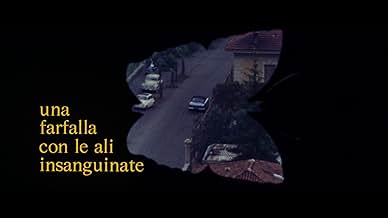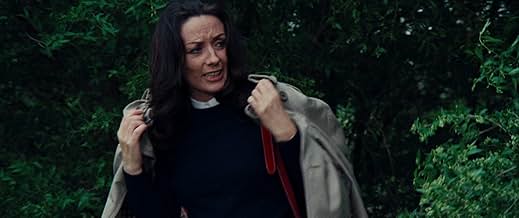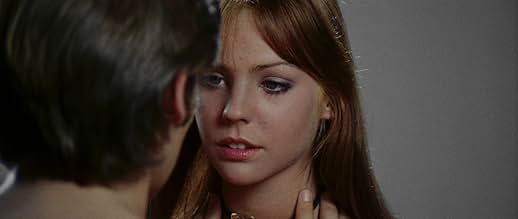Un papillon aux ailes ensanglantées
Original title: Una farfalla con le ali insanguinate
IMDb RATING
6.3/10
2.2K
YOUR RATING
A popular television presenter is accused of killing a teenage girl in a park, who happens to be his daughter's best friend.A popular television presenter is accused of killing a teenage girl in a park, who happens to be his daughter's best friend.A popular television presenter is accused of killing a teenage girl in a park, who happens to be his daughter's best friend.
Ida Galli
- Maria Marchi
- (as Evelyn Stewart)
Wendy D'Olive
- Sarah Marchi
- (as Wendi D'Olive)
Gabriella D'Olive
- Gabriella Giusti
- (as Gabriella Venditti)
Antonio Anelli
- Journalist
- (uncredited)
Gisella Burinato
- The forensic Chemist
- (uncredited)
Featured reviews
A middle aged male TV presenter is arrested and convicted of the murder of a 17 year old French girl in a park, however the killings continue..
Whereas many Italian giallo movies have plots that are over complicated or lack logic this one is easy to follow, it's quite straight forward, perhaps even a tad predictable, but that's good. That's not to say that it doesn't have the odd twist.
I came into this film worried that the courtroom scenes may drag this film down but it doesn't. It's integral to the plot and, like everything else about this film, is well done. Beautifully filmed and superb musical score. There's a dash of humour regarding the investigating police office and his taste in coffee. Rated 15 in the UK, it may lack the bloodshed & nudity of other giallo that are rated 18 but this is a fantastic example of these movies, highly recommended. And watch it in Italian, not dubbed!
Though Mario Bava had gotten the Giallo ball rolling in 1964 with "Blood And Black Lace" (though some may argue that it was really 1962's "Evil Eye/ The Girl Who New Too Much" that was really the first Giallo), it wasn't really until Dario Argento's 1969 masterpiece "The Bird With The Crystal Plumage" that started the Italian Production trend. But between 1970 to 1972 it was in it's full swing!
They must have been throwing these films out weekly! But Duccio Tessari's 1971 Giallo "The Bloodstained Butterfly" is a standout for many reasons. First it takes a slightly different approach in it's proceedings, anouncing the characters names like an Agatha Christie thriller. It contains a lush hypnotic soundtrack supplied by Gianni Ferrio (that blends out of a jarring Tchaikovsky number), that fits in snuggly with Ennio Morricone's doodlings (yet retains it's own originality). The entire cast is solid, with Helmut Berger's Giorgio (a pianist) going mental every time he hears Tchaikovsky, and Giancarlo Sbragia (the main suspect) looking timid (yet shifty) while trying to defend himself. Red herrings abound (everyone seems slightly guilty and slimey) the story weaves a web of perplexity until the surprising (or not so surprising if you've seen enough Giallos) climax. Dementia out of passion is called into explanation, and this is not just your regular moral avenger or greedy interloper Giallo. Beautiful Wendy D'Olive plays the daughter of the suspect (the only character who isn't dipped in slime), and one can't help but feel that this poor character will probably suffer a nervous breakdown at the end of the chaos. To give away the story would be a crime, because this is what keeps the interest jumping. Again the black gloved assassin is taking the lives of beautiful women, but this tends to feel like a more mature outing with restrained gore. The emphasis is placed on the convoluted, puzzling story. One thing that makes Giallo films so great is that it's stylized trash. Not simply just stalk n' slash fair (unlike so many of America's horror films of the time), but great detail is placed on locations, clothes, interior decoration, and music. Giallo films tend to seduce (before destroying) it's viewer with everything abound incorporating a lushous veneer.
"Bloodstained Butterfly" is a prime example of this asthetic. One of my favourite moments of the film is when Wendy D'Olive is taking a tram through the city, while Helmut Berger is driving his sports car right before their chance (or maybe it isn't?) meeting. The wonderful music glides you through the scene like an Italian daydream, only to drop you into a scene of suspicion. Highly recommended for fans of Italian Cinema!
They must have been throwing these films out weekly! But Duccio Tessari's 1971 Giallo "The Bloodstained Butterfly" is a standout for many reasons. First it takes a slightly different approach in it's proceedings, anouncing the characters names like an Agatha Christie thriller. It contains a lush hypnotic soundtrack supplied by Gianni Ferrio (that blends out of a jarring Tchaikovsky number), that fits in snuggly with Ennio Morricone's doodlings (yet retains it's own originality). The entire cast is solid, with Helmut Berger's Giorgio (a pianist) going mental every time he hears Tchaikovsky, and Giancarlo Sbragia (the main suspect) looking timid (yet shifty) while trying to defend himself. Red herrings abound (everyone seems slightly guilty and slimey) the story weaves a web of perplexity until the surprising (or not so surprising if you've seen enough Giallos) climax. Dementia out of passion is called into explanation, and this is not just your regular moral avenger or greedy interloper Giallo. Beautiful Wendy D'Olive plays the daughter of the suspect (the only character who isn't dipped in slime), and one can't help but feel that this poor character will probably suffer a nervous breakdown at the end of the chaos. To give away the story would be a crime, because this is what keeps the interest jumping. Again the black gloved assassin is taking the lives of beautiful women, but this tends to feel like a more mature outing with restrained gore. The emphasis is placed on the convoluted, puzzling story. One thing that makes Giallo films so great is that it's stylized trash. Not simply just stalk n' slash fair (unlike so many of America's horror films of the time), but great detail is placed on locations, clothes, interior decoration, and music. Giallo films tend to seduce (before destroying) it's viewer with everything abound incorporating a lushous veneer.
"Bloodstained Butterfly" is a prime example of this asthetic. One of my favourite moments of the film is when Wendy D'Olive is taking a tram through the city, while Helmut Berger is driving his sports car right before their chance (or maybe it isn't?) meeting. The wonderful music glides you through the scene like an Italian daydream, only to drop you into a scene of suspicion. Highly recommended for fans of Italian Cinema!
Behind a typically abstruse giallo title (the plot's link to a butterfly of any kind is extremely tenuous) lies a film that rarely feels like a typical giallo, with more police procedure and courtroom drama than usual. Director Duccio Tessari's film opens in familiar territory with the murder of a young woman in a park, the killer, in raincoat and hat, making his escape, but witnessed by several people. The police investigate the crime scene, forensics gathering numerous pieces of evidence, all of which points to TV reporter Alessandro Marchi (Giancarlo Sbragia) as the guilty party. The rest of the first half of the film is dedicated to the trial of Allesandro, with dreary flashbacks and cross-examination making the film something of a chore to sit through.
Found guilty of murder, Allesandro is sentenced to life, but while he is in prison, the killings continue, the modus operandi the same as before, the culprit contacting the police with a whispered phone call. When Allesandro's mistress comes forward with vital information that seems to prove his innocence, Allesandro is freed (much to the annoyance of his wife, who also has a lover). After much intrigue, Tessari eventually pulls together all the plot threads for an unexpected twist ending that goes some way to make the duller moments seem a bit more worthwhile. As far as the death scenes go, they are extremely tame and likely to disappoint fans of Argento or Fulci, and despite a fair few attractive women, the level of nudity is also fairly low.
Perhaps the most notable things about the film are its police inspector's strange obsession with coffee, and the cop who falls over running down some stairs during a chase on foot through the streets of Milan (it looks unintentional and is never spoken of).
5.5/10, rounded up to 6 for IMDb.
Found guilty of murder, Allesandro is sentenced to life, but while he is in prison, the killings continue, the modus operandi the same as before, the culprit contacting the police with a whispered phone call. When Allesandro's mistress comes forward with vital information that seems to prove his innocence, Allesandro is freed (much to the annoyance of his wife, who also has a lover). After much intrigue, Tessari eventually pulls together all the plot threads for an unexpected twist ending that goes some way to make the duller moments seem a bit more worthwhile. As far as the death scenes go, they are extremely tame and likely to disappoint fans of Argento or Fulci, and despite a fair few attractive women, the level of nudity is also fairly low.
Perhaps the most notable things about the film are its police inspector's strange obsession with coffee, and the cop who falls over running down some stairs during a chase on foot through the streets of Milan (it looks unintentional and is never spoken of).
5.5/10, rounded up to 6 for IMDb.
I love that in the seventies, you could pull up to a petrol station get out next to the pumps, try and light up a cigarette, find out the packet is empty, throw the empty packet on the ground, then go and pick up a hooker.
This seems to be a blend of the old school gialli (rich, soulless socialites double crossing each other) and the new gialli (gloved killer, stabbing) that has a middle part that centres around a murder prosecution. You might need a little patience.
After we're introduced to our characters with their names appearing onscreen beside them, we see a girl's corpse tumbling down a hill in a park and being found by two kids. Several witnesses spot a person in a mac stumbling through the park, with one lady claiming that the killer is a well known television personality whose daughter coincidentally it the murdered girl's best friend. However, a dazed Helmet Berger is seen staggering around the place too, so we know that things are going to get convoluted pretty quickly.
Cop Silvio Tranquilli is brought in to...well, not break these case as they get a suspect pretty quickly, but he does complain about coffee a lot. Plus, this whole sequence gives director Duccio Tessari a chance to give us all sorts of freaky camera angles while the police use scientific methods that seems to quickly lead to a healthy case to send down the TV presenter.
However, the suspect also has a pretty good lawyer who may very well get him off the hook. Well, nearly. After the presenter's wife (Ida Galli) accidentally gets the guy sent down, things get very giallo like as true motives are revealed, the double crosses begin, and the murders seemingly continue, even though the killer is in jail.
To give you an idea of the pace of this film, the police are still standing over the first victim's body eighteen minutes into the film. Then you get the courtroom drama and the mystery of what Helmet Berger has to do with it all. Duccio Tessari is no fool, however. His eye for good visuals shines through and we get a change of scenery as the film is set in Bologna, not a place that turns up frequently in these films.
It does drag, but the ending is worth waiting for. I'd been after this one for ages and although it's good, I don't think I'd ever watch it again.
This seems to be a blend of the old school gialli (rich, soulless socialites double crossing each other) and the new gialli (gloved killer, stabbing) that has a middle part that centres around a murder prosecution. You might need a little patience.
After we're introduced to our characters with their names appearing onscreen beside them, we see a girl's corpse tumbling down a hill in a park and being found by two kids. Several witnesses spot a person in a mac stumbling through the park, with one lady claiming that the killer is a well known television personality whose daughter coincidentally it the murdered girl's best friend. However, a dazed Helmet Berger is seen staggering around the place too, so we know that things are going to get convoluted pretty quickly.
Cop Silvio Tranquilli is brought in to...well, not break these case as they get a suspect pretty quickly, but he does complain about coffee a lot. Plus, this whole sequence gives director Duccio Tessari a chance to give us all sorts of freaky camera angles while the police use scientific methods that seems to quickly lead to a healthy case to send down the TV presenter.
However, the suspect also has a pretty good lawyer who may very well get him off the hook. Well, nearly. After the presenter's wife (Ida Galli) accidentally gets the guy sent down, things get very giallo like as true motives are revealed, the double crosses begin, and the murders seemingly continue, even though the killer is in jail.
To give you an idea of the pace of this film, the police are still standing over the first victim's body eighteen minutes into the film. Then you get the courtroom drama and the mystery of what Helmet Berger has to do with it all. Duccio Tessari is no fool, however. His eye for good visuals shines through and we get a change of scenery as the film is set in Bologna, not a place that turns up frequently in these films.
It does drag, but the ending is worth waiting for. I'd been after this one for ages and although it's good, I don't think I'd ever watch it again.
While walking through a park in a rainy day, the young Françoise Pigaut (Carole André) is stabbed to death by man wearing raincoat and hat. Inspector Berardi (Silvano Tranquilli) is assigned to investigate the case and soon the TV anchor Alessandro Marchi (Giancarlo Sbragia) becomes the prime suspect. His daughter Sarah Marchi (Wendi D'Olive) was Françoise's best friend and their common friend Giorgio (Helmut Berger) had a crush on Françoise. Alessandro's friend and attorney Giulio Cordaro (Günther Stoll) defends him in the court but Alessandro is found guilty and sent to prison. When two other women are murdered and it is found that Alessandro's wife Maria Marchi (Evelyn Stewart) is the lover of Giulio, the defense asks for mistrial and Alessandro has another trial. Who might be the killer?
"Una farfalla con le ali insanguinate", a.k.a. "The Bloodstained Butterfly", is a crime story with a great twist in the end. The suspenseful screenplay begins with the presentation of several characters and is confused, and the slow pace is tiresome. But the story is good, and the unexpected conclusion surprises the viewer. My vote is seven.
Title (Brazil): "Uma Borboleta com as Asas Ensanguentadas" ("A Butterfly with the Bloodstained Wings")
"Una farfalla con le ali insanguinate", a.k.a. "The Bloodstained Butterfly", is a crime story with a great twist in the end. The suspenseful screenplay begins with the presentation of several characters and is confused, and the slow pace is tiresome. But the story is good, and the unexpected conclusion surprises the viewer. My vote is seven.
Title (Brazil): "Uma Borboleta com as Asas Ensanguentadas" ("A Butterfly with the Bloodstained Wings")
Did you know
- TriviaDuring pre-production, the film was promoted as an adaptation of an Edgar Wallace story. Less then two weeks before principal photography, the West German companies Rialto Film and Constantine Film (who were co-producing the movie) pulled out for unknown reasons, and any reference to Wallace was removed from the final film. The German connection is still reflected via Günther Stoll and Wolfgang Preiss, both stars of Rialto's Wallace adaptations (better known as 'krimi' films).
- GoofsIn the scene immediately following the credits, a woman with a couple of children playing in a park expresses concern that it's about to rain, pleading with the children repeatedly to stop their games and return home with her at once. A corpse rolls down in the bushes and the children turn around, only to see that the woman responsible for them has abandoned them, left in their dangerous circumstances, to run for the police.
- Quotes
Attorney Giulio Cordaro: We all know that in the park one finds a cesspool of voyeurs, thieves, homosexuals, and other unsavory types.
- ConnectionsFeatured in Mad Dog Helmut (2016)
- SoundtracksConcerto No. 1 for Piano and Orchestra
By Tschaikowsky
- How long is The Bloodstained Butterfly?Powered by Alexa
Details
- Runtime
- 1h 39m(99 min)
- Aspect ratio
- 2.35 : 1
Contribute to this page
Suggest an edit or add missing content




























